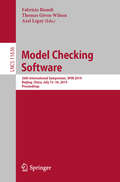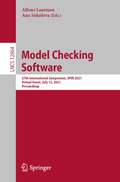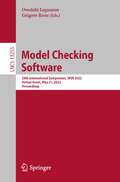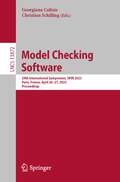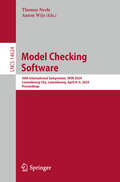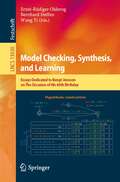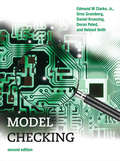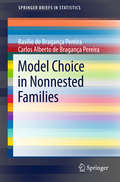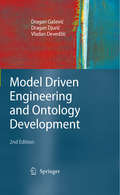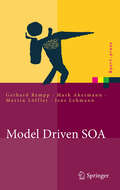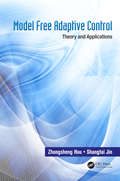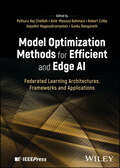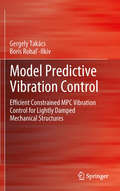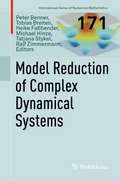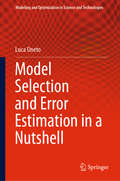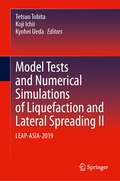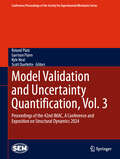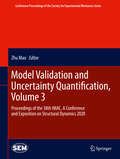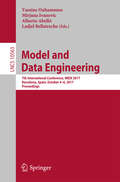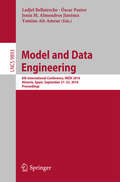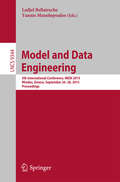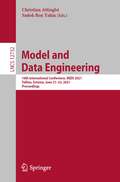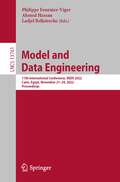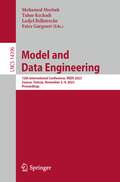- Table View
- List View
Model Checking Software: 26th International Symposium, SPIN 2019, Beijing, China, July 15–16, 2019, Proceedings (Lecture Notes in Computer Science #11636)
by Axel Legay Fabrizio Biondi Thomas Given-WilsonThis book constitutes the refereed proceedings of the 26th International Symposium on Model Checking Software, SPIN 2019, held in Beijing, China, in July 2019. The 11 full papers presented and 2 demo-tool papers, were carefully reviewed and selected from 29 submissions. Topics covered include formal verification techniques for automated analysis of software; formal analysis for modeling languages, such as UML/state charts; formal specification languages, temporal logic, design-by-contract; model checking, automated theorem proving, including SAT and SMT; verifying compilers; abstraction and symbolic execution techniques; and much more.
Model Checking Software: 27th International Symposium, SPIN 2021, Virtual Event, July 12, 2021, Proceedings (Lecture Notes in Computer Science #12864)
by Ana Sokolova Alfons LaarmanThis book constitutes the refereed proceedings of the 27th International Symposium on Model Checking Software, SPIN 2021, held virtually in July 2021.The 3 full papers, 4 tool papers, and 1 case study presented together with 2 invited talks were carefully reviewed and selected from 20 submissions. Topics covered include formal verification techniques for automated analysis of software; formal analysis for modeling languages, such as UML/state charts; formal specification languages, temporal logic, design-by-contract; model checking, automated theorem proving, including SAT and SMT; verifying compilers; abstraction and symbolic execution techniques; and much more.
Model Checking Software: 28th International Symposium, SPIN 2022, Virtual Event, May 21, 2022, Proceedings (Lecture Notes in Computer Science #13255)
by Grigore Rosu Owolabi LegunsenThis book constitutes the refereed proceedings of the 28th International Symposium on Model Checking Software, SPIN 2022, held virtually in May 2022.The 8 full papers were carefully reviewed and selected from 11 submissions. Topics covered include formal verification techniques for automated analysis of software; formal analysis for modeling languages, such as UML/state charts; formal specification languages, temporal logic, design-by-contract; model checking, automated theorem proving, including SAT and SMT; verifying compilers; abstraction and symbolic execution techniques; and much more.
Model Checking Software: 29th International Symposium, SPIN 2023, Paris, France, April 26–27, 2023, Proceedings (Lecture Notes in Computer Science #13872)
by Georgiana Caltais Christian SchillingThis book constitutes the refereed proceedings of the 29th International Symposium on Model Checking Software, SPIN 2023, held in Paris, France, during April 26–27, 2023. The 9 full papers and 2 short papers included in this book were carefully reviewed and selected from 21 submissions. They were organized in topical sections as follows: binary decision diagrams, concurrency, testing, synthesis, explicit-state model checking.
Model Checking Software: 30th International Symposium, SPIN 2024, Luxembourg City, Luxembourg, April 8–9, 2024, Proceedings (Lecture Notes in Computer Science #14624)
by Anton Wijs Thomas NeeleThis book constitutes the refereed proceedings of the 30th International Symposium on Model Checking Software, SPIN 2024, held in Luxembourg City, Luxembourg, during April 10-11, 2024. The 9 full papers, 3 short papers and 2 invited papers included in this book were carefully reviewed and selected from 23 submissions. They are organized in topical sections as follows: model checking; anniversary; automated reasoning; and verification tools.
Model Checking, Synthesis, and Learning: Essays Dedicated to Bengt Jonsson on The Occasion of His 60th Birthday (Lecture Notes in Computer Science #13030)
by Bernhard Steffen Ernst-Rüdiger Olderog Wang YiThis Festschrift, dedicated to Bengt Jonsson on the occasion of his 60th birthday, contains papers written by many of his friends and collaborators.Bengt has made major contributions covering a wide range of topics including verification and learning. His works on verification, in finite state systems, learning, testing, probabilistic systems, timed systems, and distributed systems reflect both the diversity and the depth of his research. Besides being an excellent scientist, Bengt is also a leader who has greatly influenced the careers of both his students and his colleagues. His main focus throughout his career has been in the area of formal methods, and the research papers dedicated to him in this volume address related topics, particularly related to model checking, temporal logic, and automata learning.
Model Checking, second edition (Cyber Physical Systems Series)
by Daniel Kroening Doron Peled Edmund M. Clarke Helmut Veith Orna GrumbergAn expanded and updated edition of a comprehensive presentation of the theory and practice of model checking, a technology that automates the analysis of complex systems.Model checking is a verification technology that provides an algorithmic means of determining whether an abstract model—representing, for example, a hardware or software design—satisfies a formal specification expressed as a temporal logic formula. If the specification is not satisfied, the method identifies a counterexample execution that shows the source of the problem. Today, many major hardware and software companies use model checking in practice, for verification of VLSI circuits, communication protocols, software device drivers, real-time embedded systems, and security algorithms. This book offers a comprehensive presentation of the theory and practice of model checking, covering the foundations of the key algorithms in depth. The field of model checking has grown dramatically since the publication of the first edition in 1999, and this second edition reflects the advances in the field. Reorganized, expanded, and updated, the new edition retains the focus on the foundations of temporal logic model while offering new chapters that cover topics that did not exist in 1999: propositional satisfiability, SAT-based model checking, counterexample-guided abstraction refinement, and software model checking. The book serves as an introduction to the field suitable for classroom use and as an essential guide for researchers.
Model Choice in Nonnested Families
by Basilio De Pereira Carlos Alberto PereiraThis book discusses the problem of model choice when the statistical models are separate, also called nonnested. Chapter 1 provides an introduction, motivating examples and a general overview of the problem. Chapter 2 presents the classical or frequentist approach to the problem as well as several alternative procedures and their properties. Chapter 3 explores the Bayesian approach, the limitations of the classical Bayes factors and the proposed alternative Bayes factors to overcome these limitations. It also discusses a significance Bayesian procedure. Lastly, Chapter 4 examines the pure likelihood approach. Various real-data examples and computer simulations are provided throughout the text.
Model Driven Engineering and Ontology Development
by Dragan Gaševic Vladan Devedžic Dragan Djuric Jean Bézivin Bran V. SelicDefining a formal domain ontology is considered a useful, not to say necessary step in almost every software project. This is because software deals with ideas rather than with self-evident physical artefacts. However, this development step is hardly ever done, as ontologies rely on well-defined and semantically powerful AI concepts such as description logics or rule-based systems, and most software engineers are unfamiliar with these. This book fills this gap by covering the subject of MDA application for ontology development on the Semantic Web. The writing is technical yet clear, and is illustrated with examples. The book is supported by a website.
Model Driven SOA
by Gerhard Rempp Jens Lehmann Mark Akermann Martin LöfflerServiceorientierte Architektur (SOA) hat sich durchgesetzt, wer sie beherrscht, hat einen Wettbewerbsvorteil. Deshalb stellt sich meist nicht die Frage, ob SOA angewendet werden soll, sondern wie sie umgesetzt werden kann. Die Autoren geben anhand eines Anwendungsbeispiels einen Überblick über die modellgetriebene Softwareentwicklung. Sie zeigen, wie sich mit Modellierungsnotationen und mit Generatoren die werkzeuggestützte Entwicklung von SOA-Anwendungen effizient und dauerhaft umsetzen lässt. Mit allen notwendigen Sourcecodes und Dokumentationen.
Model Free Adaptive Control: Theory and Applications
by Zhongsheng Hou Shangtai JinModel Free Adaptive Control: Theory and Applications summarizes theory and applications of model-free adaptive control (MFAC). MFAC is a novel adaptive control method for the unknown discrete-time nonlinear systems with time-varying parameters and time-varying structure, and the design and analysis of MFAC merely depend on the measured input and ou
Model Optimization Methods for Efficient and Edge AI: Federated Learning Architectures, Frameworks and Applications
by Robert Colby Pethuru Raj Chelliah Amir Masoud Rahmani Gayathri Nagasubramanian Sunku RanganathComprehensive overview of the fledgling domain of federated learning (FL), explaining emerging FL methods, architectural approaches, enabling frameworks, and applications Model Optimization Methods for Efficient and Edge AI explores AI model engineering, evaluation, refinement, optimization, and deployment across multiple cloud environments (public, private, edge, and hybrid). It presents key applications of the AI paradigm, including computer vision (CV) and Natural Language Processing (NLP), explaining the nitty-gritty of federated learning (FL) and how the FL method is helping to fulfill AI model optimization needs. The book also describes tools that vendors have created, including FL frameworks and platforms such as PySyft, Tensor Flow Federated (TFF), FATE (Federated AI Technology Enabler), Tensor/IO, and more. The first part of the text covers popular AI and ML methods, platforms, and applications, describing leading AI frameworks and libraries in order to clearly articulate how these tools can help with visualizing and implementing highly flexible AI models quickly. The second part focuses on federated learning, discussing its basic concepts, applications, platforms, and its potential in edge systems (such as IoT). Other topics covered include: Building AI models that are destined to solve several problems, with a focus on widely articulated classification, regression, association, clustering, and other prediction problemsGenerating actionable insights through a variety of AI algorithms, platforms, parallel processing, and other enablersCompressing AI models so that computational, memory, storage, and network requirements can be substantially reducedAddressing crucial issues such as data confidentiality, data access rights, data protection, and access to heterogeneous dataOvercoming cyberattacks on mission-critical software systems by leveraging federated learning Written in an accessible manner and containing a helpful mix of both theoretical concepts and practical applications, Model Optimization Methods for Efficient and Edge AI is an essential reference on the subject for graduate and postgraduate students, researchers, IT professionals, and business leaders.
Model Predictive Vibration Control
by Boris Rohaľ-Ilkiv Gergely TakácsReal-time model predictive controller (MPC) implementation in active vibration control (AVC) is often rendered difficult by fast sampling speeds and extensive actuator-deformation asymmetry. If the control of lightly damped mechanical structures is assumed, the region of attraction containing the set of allowable initial conditions requires a large prediction horizon, making the already computationally demanding on-line process even more complex. Model Predictive Vibration Control provides insight into the predictive control of lightly damped vibrating structures by exploring computationally efficient algorithms which are capable of low frequency vibration control with guaranteed stability and constraint feasibility. In addition to a theoretical primer on active vibration damping and model predictive control, Model Predictive Vibration Control provides a guide through the necessary steps in understanding the founding ideas of predictive control applied in AVC such as: · the implementation of computationally efficient algorithms · control strategies in simulation and experiment and · typical hardware requirements for piezoceramics actuated smart structures. The use of a simple laboratory model and inclusion of over 170 illustrations provides readers with clear and methodical explanations, making Model Predictive Vibration Control the ideal support material for graduates, researchers and industrial practitioners with an interest in efficient predictive control to be utilized in active vibration attenuation.
Model Reduction of Complex Dynamical Systems (International Series of Numerical Mathematics #171)
by Peter Benner Michael Hinze Tatjana Stykel Ralf Zimmermann Tobias Breiten Heike FaßbenderThis contributed volume presents some of the latest research related to model order reduction of complex dynamical systems with a focus on time-dependent problems. Chapters are written by leading researchers and users of model order reduction techniques and are based on presentations given at the 2019 edition of the workshop series Model Reduction of Complex Dynamical Systems – MODRED, held at the University of Graz in Austria. The topics considered can be divided into five categories:system-theoretic methods, such as balanced truncation, Hankel norm approximation, and reduced-basis methods; data-driven methods, including Loewner matrix and pencil-based approaches, dynamic mode decomposition, and kernel-based methods;surrogate modeling for design and optimization, with special emphasis on control and data assimilation;model reduction methods in applications, such as control and network systems, computational electromagnetics, structural mechanics, and fluid dynamics; andmodel order reduction software packages and benchmarks.This volume will be an ideal resource for graduate students and researchers in all areas of model reduction, as well as those working in applied mathematics and theoretical informatics.
Model Selection and Error Estimation in a Nutshell (Modeling and Optimization in Science and Technologies #15)
by Luca OnetoHow can we select the best performing data-driven model? How can we rigorously estimate its generalization error? Statistical learning theory answers these questions by deriving non-asymptotic bounds on the generalization error of a model or, in other words, by upper bounding the true error of the learned model based just on quantities computed on the available data. However, for a long time, Statistical learning theory has been considered only an abstract theoretical framework, useful for inspiring new learning approaches, but with limited applicability to practical problems. The purpose of this book is to give an intelligible overview of the problems of model selection and error estimation, by focusing on the ideas behind the different statistical learning theory approaches and simplifying most of the technical aspects with the purpose of making them more accessible and usable in practice. The book starts by presenting the seminal works of the 80’s and includes the most recent results. It discusses open problems and outlines future directions for research.
Model Tests and Numerical Simulations of Liquefaction and Lateral Spreading II: LEAP-ASIA-2019
by Tetsuo Tobita Koji Ichii Kyohei UedaThis open access book presents work collected through the Liquefaction Experiments and Analysis Projects (LEAP) in 2019 (LEAP-ASIA-2019) following the LEAP-UCD-2017 whose results have been published as a first volume. In addition to the research targets set in the previous one, such as the repeatability, variability, and sensitivity of lateral spreading on mildly sloping liquefiable sand, this volume includes research efforts to validate the generalized scaling law (hereafter “GSL”) for the identical prototype with the one employed in UCD-2017. In LEAP-ASIA-2019, 10 institutes around the world conducted 23 tests in total. It was the first multi-institutional attempts to investigate the validity of the generalized scaling law for the saturated sandy sloping deposit with wide range of initial conditions. The experimental data provided a unique basis for assessing the capabilities of six different simulation platforms for numerical simulation of soil liquefaction. The results of the experiments and the numerical simulations are presented and discussed in papers submitted by the project participants.
Model Validation and Uncertainty Quantification, Vol. 3: Proceedings of the 42nd IMAC, A Conference and Exposition on Structural Dynamics 2024 (Conference Proceedings of the Society for Experimental Mechanics Series)
by Roland Platz Garrison Flynn Kyle Neal Scott OuelletteModel Validation and Uncertainty Quantification, Volume 3: Proceedings of the 42nd IMAC, A Conference and Exposition on Structural Dynamics, 2024, the third volume of ten from the Conference brings together contributions to this important area of research and engineering. The collection presents early findings and case studies on fundamental and applied aspects of Model Validation and Uncertainty Quantification, including papers on: Uncertainty Quantification in Dynamics Fusion of Test and Analysis Model Form Uncertainty: Round Robin Challenge UQVI (Uncertainty Quantification in Vibration Isolation) Recursive Bayesian System Identification Virtual Sensing & Realtime Monitoring Surrogate Modeling and Reduced Order Models
Model Validation and Uncertainty Quantification, Volume 3: Proceedings of the 38th IMAC, A Conference and Exposition on Structural Dynamics 2020 (Conference Proceedings of the Society for Experimental Mechanics Series)
by Zhu MaoModel Validation and Uncertainty Quantification, Volume 3: Proceedings of the 38th IMAC, A Conference and Exposition on Structural Dynamics, 2020, the third volume of nine from the Conference brings together contributions to this important area of research and engineering. The collection presents early findings and case studies on fundamental and applied aspects of Model Validation and Uncertainty Quantification, including papers on:Uncertainty Quantification in Material ModelsUncertainty Propagation in Structural DynamicsPractical Applications of MVUQAdvances in Model Validation & Uncertainty Quantification: Model UpdatingModel Validation & Uncertainty Quantification: Industrial ApplicationsControlling UncertaintyUncertainty in Early Stage DesignModeling of Musical InstrumentsOverview of Model Validation and Uncertainty
Model Validation and Uncertainty Quantification, Volume 3: Proceedings of the 41st IMAC, A Conference and Exposition on Structural Dynamics 2023 (Conference Proceedings of the Society for Experimental Mechanics Series)
by Roland Platz Garrison Flynn Kyle Neal Scott OuelletteModel Validation and Uncertainty Quantification, Volume 3: Proceedings of the 41st IMAC, A Conference and Exposition on Structural Dynamics, 2023, the third volume of ten from the Conference brings together contributions to this important area of research and engineering. The collection presents early findings and case studies on fundamental and applied aspects of Model Validation and Uncertainty Quantification, including papers on:Introduction of Uncertainty QuantificationUncertainty Quantification in DynamicsModel Form Uncertainty and Selection incl. Round Robin ChallengeSensor and Information FusionVirtual Sensing, Certification, and Real-Time MonitoringSurrogate Modeling
Model and Data Engineering
by Alberto Abelló Ladjel Bellatreche Yassine Ouhammou Mirjana IvanovicThis book constitutes the refereed proceedings of the 7th International Conference on Model and Data Engineering, MEDI 2017, held in Barcelona, Spain, in October 2017. The 20 full papers and 7 short papers presented together with 2 invited talks were carefully reviewed and selected from 69 submissions. The papers are organized in topical sections on domain specific languages; systems and software assessments; modeling and formal methods; data engineering; data exploration and exp loitation; modeling heterogeneity and behavior; model-based applications; and ontology-based applications.
Model and Data Engineering
by Ladjel Bellatreche Óscar Pastor Jesús M. Almendros Jiménez Yamine Aït-AmeurThis book constitutes the refereed proceedings of the 2nd International Conference on Model and Data Engineering, MEDI 2012, held in Poitiers, France, in October 2012. The 12 revised full papers presented together with 5 short papers were carefully reviewed and selected from 35 submissions. The papers are cover the topics of model driven engineering, ontology engineering, formal modeling, security, and data mining.
Model and Data Engineering
by Ladjel Bellatreche Yannis ManolopoulosThis book constitutes the refereed proceedings of the 5th International Conference on Model and Data Engineering, MEDI 2015, held in Rhodes, Greece, in September 2015. The 18 full papers and 9 short papers presented together with 2 invited talks were carefully reviewed and selected from 55 submissions. The papers are organized in topical sections such as modeling and meta modeling; ontology-based modeling, reasoning and reuse; event-B and modeling languages; context modeling and model transformation; data mining; query processing; modeling activities and inference; prediction and recommendation; requirement and systems engineering.
Model and Data Engineering: 10th International Conference, MEDI 2021, Tallinn, Estonia, June 21–23, 2021, Proceedings (Lecture Notes in Computer Science #12732)
by Christian Attiogbé Sadok Ben YahiaThis book constitutes the refereed proceedings of the 10th International Conference on Model and Data Engineering, MEDI 2021, held in Tallinn, Estonia, in June 2021. The 16 full papers and 8 short papers presented in this book were carefully reviewed and selected from 47 submissions. Additionally, the volume includes 3 abstracts of invited talks. The papers cover broad research areas on both theoretical, systems and practical aspects. Some papers include mining complex databases, concurrent systems, machine learning, swarm optimization, query processing, semantic web, graph databases, formal methods, model-driven engineering, blockchain, cyber physical systems, IoT applications, and smart systems.Due to the Corona pandemic the conference was held virtually.
Model and Data Engineering: 11th International Conference, MEDI 2022, Cairo, Egypt, November 21–24, 2022, Proceedings (Lecture Notes in Computer Science #13761)
by Ladjel Bellatreche Philippe Fournier-Viger Ahmed HassanThis book constitutes the refereed proceedings of the 11th International Conference on Model and Data Engineering, MEDI 2022, held in Cairo, Egypt, in November 2022. The 18 full papers presented in this book were carefully reviewed and selected from 65 submissions. The papers cover topics such as database systems, data stream analysis, knowledge-graphs, machine learning, model-driven engineering, image processing, diagnosis, natural language processing, optimization, and advanced applications such as the internet of things and healthcare.
Model and Data Engineering: 12th International Conference, MEDI 2023, Sousse, Tunisia, November 2–4, 2023, Proceedings (Lecture Notes in Computer Science #14396)
by Faiez Gargouri Ladjel Bellatreche Mohamed Mosbah Tahar KechadiThis volume LNCS 14396 constitutes the refereed proceedings of the 12th International Conference, MEDI 2023,in November 2023 ,held in Sousse, Tunisia. The 27 full papers were carefully peer reviewed and selected from 99 submissions. The Annual International Conference on Model and Data Engineering focuses on bring together researchers and practitioners and enabling them to showcase the latest advances in modelling and data management.
